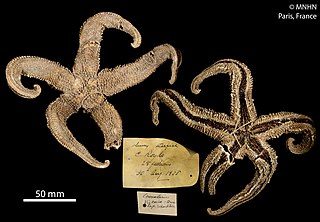
Starfish or sea stars are star-shaped echinoderms belonging to the class Asteroidea. Common usage frequently finds these names being also applied to ophiuroids, which are correctly referred to as brittle stars or basket stars. Starfish are also known as asteroids due to being in the class Asteroidea. About 1,900 species of starfish live on the seabed in all the world's oceans, from warm, tropical zones to frigid, polar regions. They are found from the intertidal zone down to abyssal depths, at 6,000 m (20,000 ft) below the surface.

The crown-of-thorns starfish, Acanthaster planci, is a large starfish that preys upon hard, or stony, coral polyps (Scleractinia). The crown-of-thorns starfish receives its name from venomous thorn-like spines that cover its upper surface, resembling the biblical crown of thorns. It is one of the largest starfish in the world.

Asterias amurensis, also known as the Northern Pacific seastar and Japanese common starfish, is a seastar found in shallow seas and estuaries, native to the coasts of northern China, Korea, far eastern Russia, Japan, Alaska, the Aleutian Islands and British Columbia in Canada. Two forms are recognised: the nominate and formarobusta from the Strait of Tartary. It mostly preys on large bivalve molluscs, and it is mostly preyed on by other species of starfish. Population booms in Japan can affect the harvest of mariculture operations and are costly to combat.

The Echinasteridae are a family of starfish in the monotypic order Spinulosida. The family includes eight genera and about 133 species found on the seabed in various habitats around the world.
Nacella macquariensis is a species of true limpet, a marine gastropod mollusc in the family Nacellidae. It is found on the lower foreshore and in the shallow sub-littoral zone of certain islands in the southern Indian Ocean and Southern Ocean.

Stichaster australis, the reef starfish, is a species of starfish found in the shallow waters of the rocky intertidal of New Zealand. Typically, the animal is endemic to the west coast shores of the North and South Islands, where wave action is increased. They do not usually inhabit ecosystems that have reduced wave action and calm conditions as they prefer a higher-energy environment. These marine invertebrates range in color from pink to purple, but can also be orange. They typically have eleven arms, but sometimes they may have either ten or twelve. As full-grown adults, they are 8 to 10 cm in diameter.

Leptasterias is a genus of starfish in the family Asteriidae. Members of this genus are characterised by having six arms although five-armed specimens sometimes occur. L. muelleri is the type species. The taxonomy of the genus is confusing and Leptasterias hexactis seems to be a species complex. Some species brood their eggs.

Leptasterias hexactis is a species of starfish in the family Asteriidae, commonly known as the six-rayed star. It is found in the intertidal zone of the western seaboard of the United States. It is a predator and is unusual among starfish in that it broods its eggs and young.

Solaster dawsoni, the morning sun star, is a species of starfish in the family Solasteridae. It is found on either side of the northern Pacific Ocean. It has two subspecies:

Labidiaster annulatus, the Antarctic sun starfish or wolftrap starfish is a species of starfish in the family Heliasteridae. It is found in the cold waters around Antarctica and has a large number of slender, flexible rays.

Leptasterias tenera is a species of starfish in the family Asteriidae. It is found on the eastern coast of North America.

Leptasterias polaris, the polar six-rayed star, is a species of starfish in the family Asteriidae. It is found in cold waters in the northwest Atlantic Ocean and in polar regions.

Pteraster militaris, the wrinkled star, is a species of starfish in the family Pterasteridae. It is found in the northern Pacific Ocean, the Arctic Ocean, the Barents Sea and the northern Atlantic Ocean.
Parvulastra parvivipara is a very small species of starfish in the family Asterinidae. It is a viviparous species and gives birth to live young. It lives in rock pools on intertidal granite rocks in a limited area of South Australia.

Patiria pectinifera, the blue bat star, is a species of starfish in the family Asterinidae. It is found in the northern Pacific Ocean along the coasts of Japan, China and Russia. It is used as a model organism in developmental biology.
Trophodiscus almus is a species of starfish in the family Astropectinidae. It is found in fairly deep waters in the Sea of Okhotsk, the Sea of Japan and around the Japanese island of Hokkaido. It is very unusual among starfish in that it broods its young on its upper surface. Its common name in Japanese is "Komochi-momiji".

Diplasterias brucei is a species of starfish in the family Asteriidae. It is found in the Pacific Ocean and Southern Ocean. It is a predator and scavenger and is unusual among starfish in that it broods its young.
Henricia lisa is a species of starfish in the family Echinasteridae found in deep water in the northern Atlantic Ocean.

Meyenaster is a genus of starfish in the family Asteriidae. It is a monotypic genus and the only species is Meyenaster gelatinosus which was first described by the Prussian botanist and zoologist Franz Julius Ferdinand Meyen in 1834. It is found in the southeastern Pacific Ocean on the coasts of South America.

Anasterias antarctica, commonly called the Cinderella starfish, is a species of starfish in the family Asteriidae. It is found in coastal waters in the Southern Ocean and around Antarctica.















